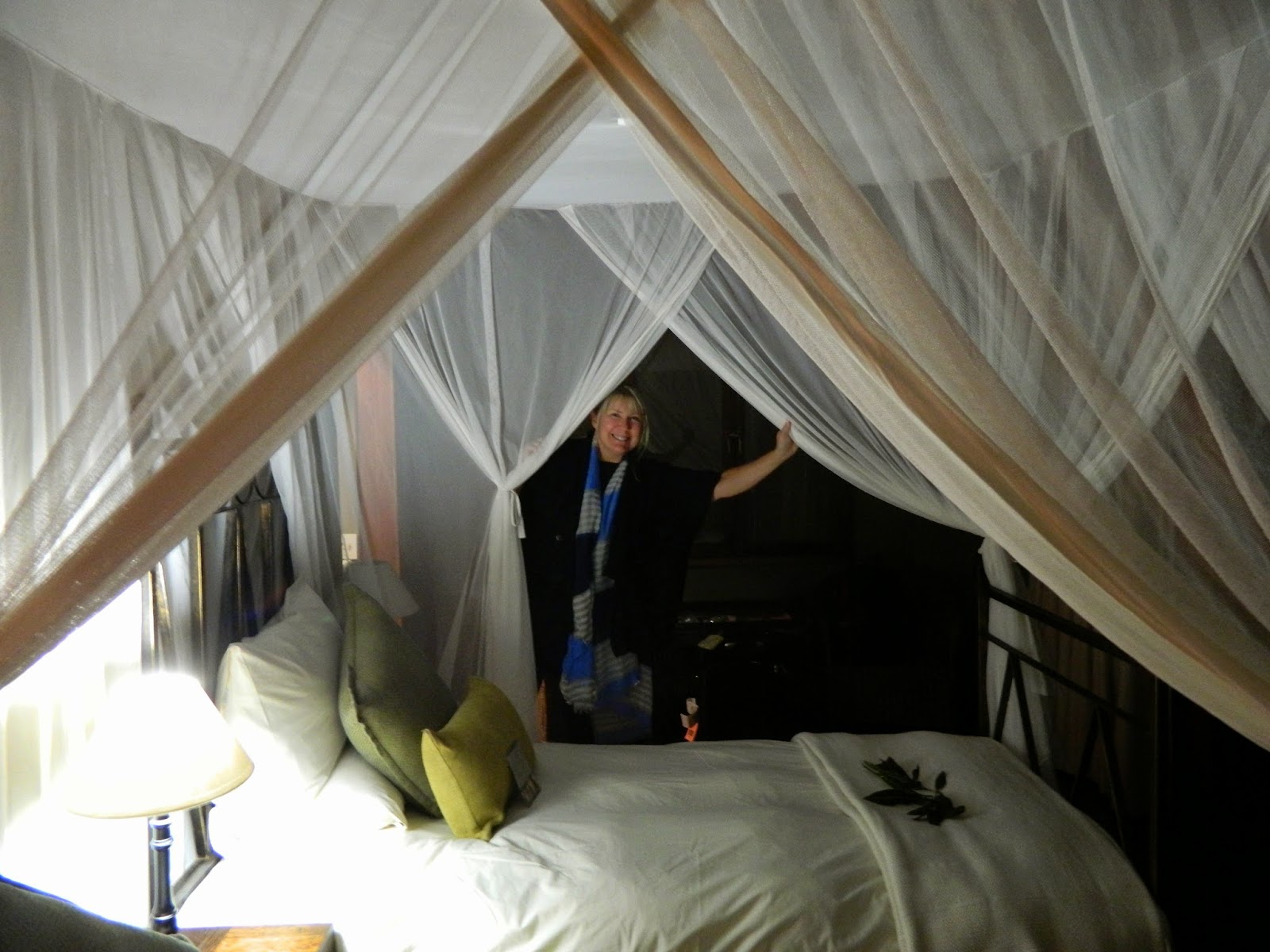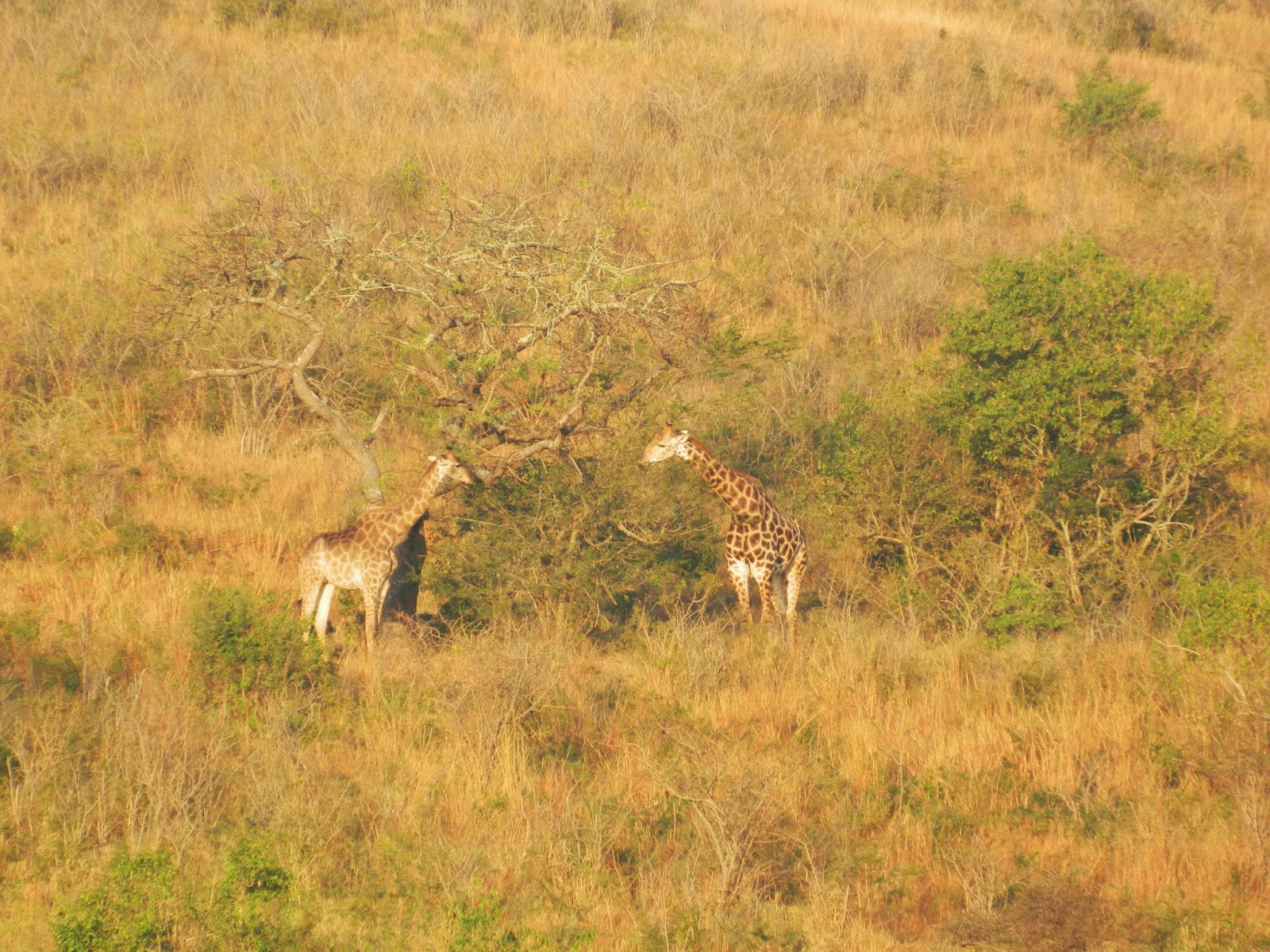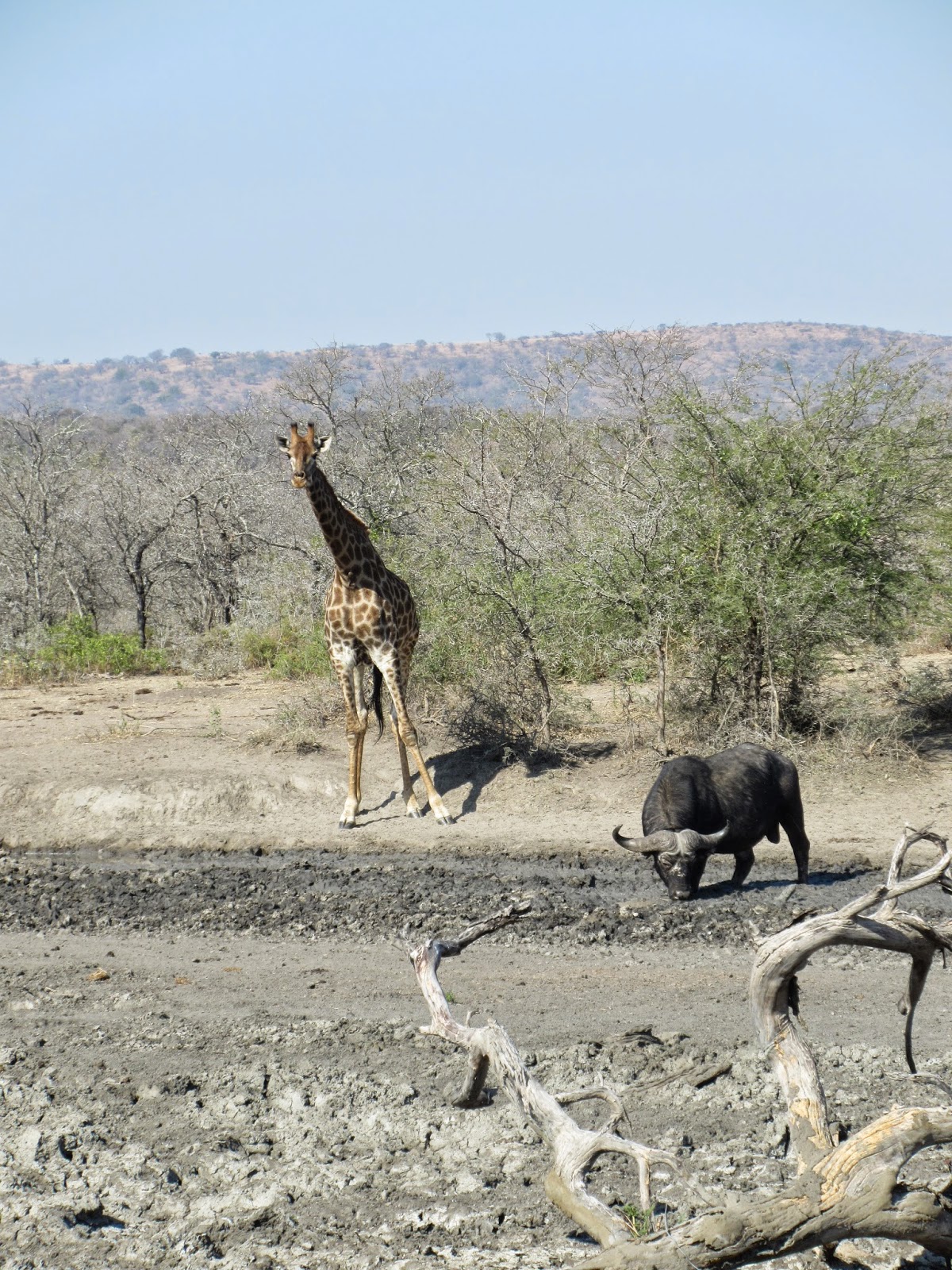Dear Mom,
Wow, what a week! I could have broken this up into several chapters, but we didn't really have wifi at our hotels. So, away we go...this might be a long one!
First off...the Dubai airport was fascinating. Even little stuff like the flight monitors in Arabic (there were English ones too), the signs for prayer rooms...and ab fab people watching.
They had an outpost for my favorite London bakery, Paul, so I enjoyed a heavenly almond croissant.
I arrived in Durban around 5 p.m., and since it's winter, it was dark by the time I got into a taxi. (Big cheer when my bag appeared on the carousel...it had been checked through from Maui!)
The hotel where I stayed in Durban was nothing exciting, but I did have an excellent salad in the little restaurant. Roasted squash, feta and pumpkin seeds with yogurt dressing.
We drove a couple of hours to an estuary at St. Lucia for a hippo cruise. It was only about 3 p.m., but since the sunset is so early, we were bathed in that gorgeous golden light of the late afternoon.
We checked into Ubizane Tree House lodge, which was really cool, very similar to the private reserve near Kruger we stayed in 2006. (The mosquito nets added a lot of ambience, even if we didn't really need them.)
Unfortunately, our schedule didn't give us much time to enjoy the lovely lodge, as we were up before sunrise for game drives and gone until dark.
They welcomed us to the lodge with a bonfire on the first night...and a scrumptious buffet, with impala pie and roast chicken and all sorts of goodies. I could have made a meal from the homemade bread alone, They also had malva pudding, a South African dessert which Va. actually introduced me to last fall when she found a recipe in a magazine at the beauty parlor (though I must say, hers was better).
We needed that fire...it was really chilly! It's winter here, but I think they were having quite a cold snap for this region, and we all found ourselves woefully under-prepared for chilly mornings in the open jeeps. After freezing the first morning, Jeanette and I snagged the terry cloth bathrobes and cotton blankets from our room and wore them.
They welcomed us to the lodge with a bonfire on the first night...and a scrumptious buffet, with impala pie and roast chicken and all sorts of goodies. I could have made a meal from the homemade bread alone, They also had malva pudding, a South African dessert which Va. actually introduced me to last fall when she found a recipe in a magazine at the beauty parlor (though I must say, hers was better).
We needed that fire...it was really chilly! It's winter here, but I think they were having quite a cold snap for this region, and we all found ourselves woefully under-prepared for chilly mornings in the open jeeps. After freezing the first morning, Jeanette and I snagged the terry cloth bathrobes and cotton blankets from our room and wore them.

We looked absurd, but it was absolutely worth it. We shed our layers as the day warmed up.
Both the owner of the lodge and our guides explained the significant issue the region faces with rhino poaching. The owner of our lodge had three rhinos, but two have now been killed by poachers, and he has cut off the horn of his surviving rhino (it's made of keratin, so it eventually grows back). Rhino horns are prized as both status symbols (apparently some uber-rich douchebags use them as chalices) and Asian medicinal ingredients, and pound-for-pound they are worth more than gold. He informed us his guards are allowed to "shoot first...ask questions later," as South African law now protects anyone who kills an armed trespasser on private property. We also learned there is a push to allow reserve owners to sell some of the horns they've stockpiled to flood the market with inventory and deflate the price...as a stopgap measure to stop the slaughter while longer-term solutions are pursued.
We saw numerous white rhinos during our game drives in the park the next day...
We were up early that first morning to meet our guides at the north end of the Hluhulwe-Imfolozi Park. Jeanette and I made a beeline for the hottest guide, Jonathan.
Imagine our delight when that pretty head turned out to be just bursting with fun facts about animals!
Seriously, the dude was practically a walking encyclopedia of animal info. (And a dreamboat to boot...what's not to like about being on safari and watching lovely creatures in action?!)
Back to the park. According to the guidebook I purchased, it's:
"...situated in the heart of KwaZulu-Natal, some 250 kilometers north of Durban. It is the province's premier game reserve and one of the biggest in South Africa, covering over 96,000 hectares of stunningly beautiful landscape, a rich compound of misty forests, grass-covered hills, dense thickets, expansive and diverse woodlands and enchanting rivers. It has the distinction of being the oldest formally protected area in Africa and has a long and interesting history."
I LOVED the topography of this park! It was much hillier and visually stunning than the area where we were near Kruger in 2006. Even when we weren't watching animals, the park itself was just beautiful; the photos can't begin to capture it. I'd love to do one of the foot safaris through the wilderness where you hike and really experience the natural wonder of the place (though apparently they do teach you to climb a tree to get away from a rhino).
The park also played a role in saving the white rhino from extinction, as the population dropped to only about twenty southern white rhino on earth in 1895, which is why the reserves were established. By the 1960s, the population had recovered to such an extent that overpopulation became an issue, and Operation Rhino was launched to capture and move rhinos to other areas.
Jonathan was VERY excited when we spotted a black rhino, as they are even rarer than white rhinos. (I now know how to tell them apart, and it has nothing to do with color, but I'll try to keep this moving along...)
He also told us about rhino dung, also known as "Facebook for rhinos." Their feces has hormonal markings that help them post social signals.
Elephants are more prevalent in the north end of the park, and we saw a large herd not long after we entered on the first morning.
Side note...it's harder than you think to get good photos on safari. Jeanette had a great camera, so she shared her memory card with me, but you end up with a lot of these...
But then occasionally you get one of these National Geographic moments...
Side note...it's harder than you think to get good photos on safari. Jeanette had a great camera, so she shared her memory card with me, but you end up with a lot of these...
But then occasionally you get one of these National Geographic moments...
Elephants are very social creatures with a lot of rules to maintain order. Females are always found within herds, and males join up from time to time. Male elephants get kicked out of the herd at about age 12 to prevent inbreeding. As herbivores, elephants can be very destructive of trees and other vegetation as they get nutrients...it's a big problem in Kruger National Park, which has a large elephant population.
We got to watch a herd of elephants walk by as the guides grilled us a tasty lunch of beef and sausages.
While I'm on the topic of food...they also stopped and served us mid-morning coffee and cookies after we'd ridden around for a few hours.
Impala are nicknamed the "McDonald's of the bush" because they are around every corner and all the predators eat them.
I love to watch giraffes, so I got a kick out of the fact that the Zulu like to say if you're a gossip, you will be a giraffe in your next life. Giraffes are high up to see everything, but they have a low voice so they can't tell anyone. Wonder why I found that so amusing?!
We saw several giraffes getting an afternoon drink, and apparently that's a rare sight, as giraffes can go for several days without water.
The measure of a successful safari is to see the "big five," a term that remains from the day of the "Great White Hunters." They are: rhino, elephant, lion, leopard and buffalo. Jonathan noted the distinction is fairly useless for photo safaris, as there are many other animals that are more interesting to observe. Nevertheless, it remains a bit of a tourist checklist. We didn't see a leopard, but those are the most difficult ones to, er, spot.
Personally, I'd rather watch zebras and even warthogs than buffalo.
There was a neat little viewing area in a hut by a watering hole where you could just sit and watch to see what happened...
Back on the Big Five...I liked this nugget of folklore from the park guidebook:
There was a neat little viewing area in a hut by a watering hole where you could just sit and watch to see what happened...
Back on the Big Five...I liked this nugget of folklore from the park guidebook:
"The Great One put the animals here for us to use wisely and respect, even as we hunted them, but He knew that without fear we might lose our respect for these creatures. So He put the five here to help us remember. The lion and leopard taught us fear of the night, that only the daytime was ours. The buffalo, the elephant and the rhino taught us to fear their strength, that we might respect the strength of nature."
On that note...stop reading now if you are squeamish...
Seriously...I'm not kidding...
Okay...Don't say I didn't warn you...You will find this either completely repulsive or absolutely fascinating...
We went into the south end of the park on the second morning to see "cats." Oh, boy, did we. We saw two lions eating a freshly-killed buffalo. This was a BIG DEAL. It seemed to have happened only a few hours before, but what made it particularly unusual was that it happened right on the road. (Apparently that's the major difference between a safari on a private reserve, which I did in 2006, and a public park. The guides have to stay on the roads in the park. So, in theory, you get much closer on a private reserve -- and you pay for it -- but neither one is Disney, and there are no guarantees of what you'll see.)
We sat and watched the lions nosh on their breakfast for about 20-30 minutes, with Jonathan saying about nine times "You guys. This. Is. Awesome." in his adorable South African accent. He was carefully watching the female lion, who was on guard to ensure we didn't try to move in for any tasty buffalo meat ourselves. The buffalo carcass was literally steaming as the warm meat hit the morning air when we got there.
It was a pretty graphic demonstration of the "circle of life," but as I wrote when I went to see The Lion King with the Bedenbaughs this winter, that whole concept seems really poignant and meaningful to me these days. Watching these wild creatures in nature made me think a lot about the process of growth and maturity and the role of a mother.
So, it was quite special on our last morning at the lodge when a few of us went for a walk with a sweet guide named Simpaul (or something like that). He started chatting away about how much he loves the seasons (though I'd say they are fairly mild here, like north Florida), and that he found it inspiring to experience winter and watch the cycle of death and rebirth in the spring. He said he loves finding spider webs on his walks, seeing the perseverance and dedication of the spiders, who reconstruct their webs so carefully after bigger creatures destroy them again and again. It resonated so deeply with me -- thoughts of nature and nurture, creatures great and small, community and every living thing's special gifts. Jonathan had talked a lot in the park about the way various animals seek particular sources of nourishment and sustenance, and it all ends up working out sort of perfectly.
To everything there is a season...and a time to every purpose under heaven...
Saudade,
Lynsley
It was a pretty graphic demonstration of the "circle of life," but as I wrote when I went to see The Lion King with the Bedenbaughs this winter, that whole concept seems really poignant and meaningful to me these days. Watching these wild creatures in nature made me think a lot about the process of growth and maturity and the role of a mother.
So, it was quite special on our last morning at the lodge when a few of us went for a walk with a sweet guide named Simpaul (or something like that). He started chatting away about how much he loves the seasons (though I'd say they are fairly mild here, like north Florida), and that he found it inspiring to experience winter and watch the cycle of death and rebirth in the spring. He said he loves finding spider webs on his walks, seeing the perseverance and dedication of the spiders, who reconstruct their webs so carefully after bigger creatures destroy them again and again. It resonated so deeply with me -- thoughts of nature and nurture, creatures great and small, community and every living thing's special gifts. Jonathan had talked a lot in the park about the way various animals seek particular sources of nourishment and sustenance, and it all ends up working out sort of perfectly.
To everything there is a season...and a time to every purpose under heaven...
Saudade,
Lynsley








































































